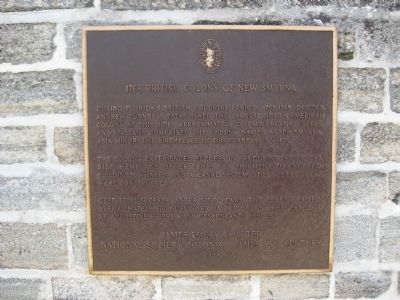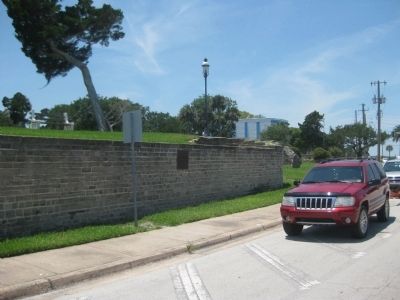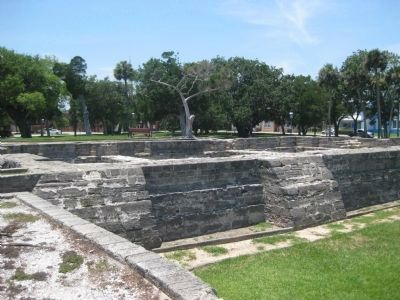New Smyrna Beach in Volusia County, Florida — The American South (South Atlantic)
1768 British Colony of New Smyrna
The colony experienced success in producing indigo dye, rice, hemp, and other crops for shipment to England. Buildings, wharfs, and a canal system, still visible today, were constructed.
Despite successes, after nine years the colony failed. Approximately 600 survivors of the colony relocated to St. Augustine where many descendants reside.
Erected 1998 by the James Emery Chapter, National Society Colonial Dames XVII Century.
Topics. This historical marker is listed in these topic lists: Colonial Era • Settlements & Settlers. A significant historical year for this entry is 1300.
Location. 29° 1.624′ N, 80° 55.297′ W. Marker is in New Smyrna Beach, Florida, in Volusia County. Marker is at the intersection of North Riverside Drive and Julia Street, on the left when traveling north on North Riverside Drive. The marker is located along the eastern edge of Old Fort Park, directly across from the city marina. Touch for map. Marker is at or near this postal address: 200 North Riverside Drive, New Smyrna Beach FL 32168, United States of America. Touch for directions.
Other nearby markers. At least 8 other markers are within walking distance of this marker. Site of Sheldon's New Smyrna Hotel (within shouting distance of this marker); Anniversary of Shelling by Union Gunboats (within shouting distance of this marker); To the Past... (about 300 feet away, measured in a direct line); Emory L. Bennett Park (about 500 feet away); Dr. Andrew Turnbull (about 500 feet away); Turnbull Canal (about 500 feet away); New Smyrna Museum Of History (about 500 feet away); The Connor Library (approx. 0.2 miles away). Touch for a list and map of all markers in New Smyrna Beach.
More about this marker. The metal marker is capped with the emblem of the Colonial Dames XVII Century and is mounted on a wall facing the street.
Inside the wall is an earthen elevation containing the remains of an ancient Native American shell mound. Built into the mound is a fortress-like foundation of quarried coquina, the exact origin of which is unknown. These features have been listed with the National Register of Historic Places under the name Old Fort Park Archaeological Site. Additionally, the site and marker both lie inside the boundaries of the New Smyrna Beach Historic District, also recognized by the NRHP.
Credits. This page was last revised on July 22, 2018. It was originally submitted on April 13, 2014, by Glenn Sheffield of Tampa, Florida. This page has been viewed 961 times since then and 34 times this year. Photos: 1, 2, 3. submitted on April 13, 2014, by Glenn Sheffield of Tampa, Florida. • Bernard Fisher was the editor who published this page.


